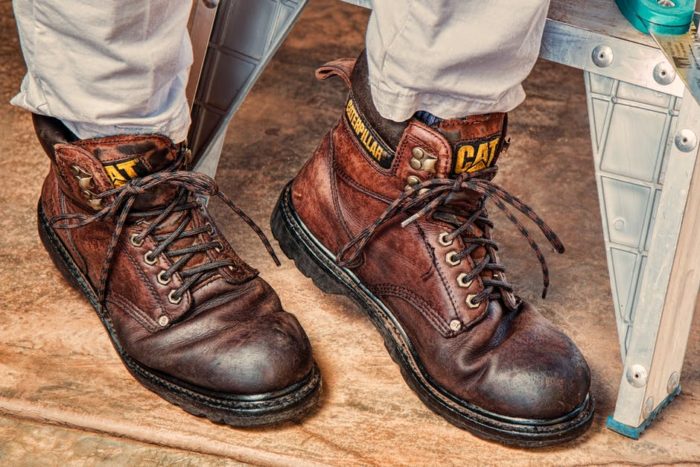
Safety Starts with Steel!
Laying a foundation for worker safety truly starts from the ground up. Many workers don’t realize how important proper safety footwear is on the job. At Diversified Staffing, we consider them another important tool — a tool for your feet that helps combat workplace hazards and discomfort and fatigue.
An estimated 120,000 men and women suffer job-related foot injuries every year. Whether the work happens in manufacturing plants and steel yards or on construction sites and farms, the need for protective footwear remains an important issue in creating safer work environments. The market is full of manufacturers introducing new boots, proprietary technologies and the latest and greatest additions to the art of safety footwear. However, understanding what you need and knowing the terminologies to navigate this sea of work boots will help you to better find what will hopefully be your favorite pair of boots. After all, comfortable feet make the work day easier and let you focus on the real job at hand.
Know your needs – How is footwear selected?
Footwear must be chosen based on the hazards that are present. Assess the workplace and work activities for:
- Materials handled or used by the worker.
- Risk of objects falling onto or striking the feet.
- Any material or equipment that might roll over the feet.
- Any sharp or pointed objects that might cut the top of the feet.
- Objects that may penetrate the bottom or side of the foot.
- Possible exposure to corrosive or irritating substances.
- Possible explosive atmospheres including the risk of static electrical discharges.
- Risk of damage to sensitive electronic components or equipment due to the discharge of static electricity.
- Risk of coming into contact with energized conductors of low to moderate voltage (e.g., 220 volts or less).
- Type of walking surface and environmental conditions workers may be exposed to (e.g., smooth surfaces, temperature, wet/oily, chemicals, etc.).
Also, evaluate the risk:
- to ankles from uneven walking surfaces or rough terrain
- of foot injury due to exposure to extreme hot or cold
- of slips and falls on slippery walking surfaces
- of exposure to water or other liquids that may penetrate the footwear causing damage to the foot and the footwear
- of exposure to rotating or abrasive machinery (e.g., chainsaws or grinders)
Fit matters!
At the end of the work day your feet should not be rubbed raw, squeezed tight or sore with blisters and abrasions. Too-tight shoes can lead to a variety of foot ailments including in-grown toe nails, blisters, corns or worse. Additionally, the wrong fit may cause discomfort in the toe box from the safety toe cap. A leather boot will stretch somewhat as it conforms to the shape of your foot; however, a steel toe will never stretch, so never purchase a pair of safety-toe boots with the idea that they will eventually break in and stretch out..
Feet don’t just get hurt while in motion – they also can be injured when standing in one place for too long. The human foot is designed for mobility. Continuous standing not only tires your feet but can cause the joints of foot bones to become misaligned. It can even cause inflammation that might later lead to rheumatism and arthritis.
Wearing the wrong footwear can cause blisters, calluses, corns, arthritis, toe malformations, fallen arches, bunions and other problems.
Finding the right size boot is very important for all-day comfort. When trying on a boot, if it feels too snug, don’t be afraid to move to a wide width.
Care:
- Use a protective coating to make footwear water-resistant.
- Inspect footwear regularly for damage (e.g., cracks in soles, breaks in leather, or exposed toe caps).
- Repair or replace worn or defective footwear.
- Electric shock resistance of footwear is greatly reduced by wet conditions and with wear.
- Footwear exposed to sole penetration or impact may not have visible signs of damage. Replacing footwear after an event is advisable
For workers exposed to foot hazards, protective footwear is essential to ensure safe and healthy feet. Safety shoes and boots protect your feet, help prevent injuries to them, and reduce the severity of injuries that do occur in the workplace. All jurisdictions in Canada require that workers wear adequate protection against workplace hazards. For workers exposed to foot hazards, the required protection is protective footwear certified by the Canadian Standards Association (CSA Standard “Protective Footwear”, CAN/CSA-Z195-09). Ensure that your protective footwear conforms with the appropriate standard for your jurisdiction. All working footwear, for both men and women, whether it is safety wear or not, should provide comfort without compromising protective value.
REMEMBER: Protective footwear is as important a tool to the workers as the equipment they use on the job site. Take time to assess your work environment, the footwear’s safety and comfort components and the proper fit when purchasing your next new pair of work footwear to ensure a comfortable day on the job.
